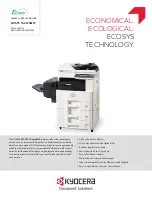
2-71
MultiPASS C530/C560 Chapter 2: Technical Reference
8.5.2 The JPEG encoding method
The JPEG encoding method (called JPEG below) originated from the group named "Joint Photograph
coding Experts Group," which is a technical organization formed by ISO and ITU-T, and is an encoding
method which is widely popular in the computer world as a method of compressing full color still image
data.
As an outline, JPEG processing compresses images in 3 levels: DCT conversion, quantification, and
entropy compression. JPEG decompression makes an image reappear by following the 3-step procedure
in reverse: entropy compression, quantification, and reverse DCT conversion. The compression ration of
JPEG image data depends on the type of image, however compression to a degree of 1/7 to 1/30,
undetectable to the naked eye, is possible. However, since the parts of the data which do not affect the
viewing eye are discarded at the time of compression, it is impossible to restore the image to its 100%
original condition when de-compressing. The characteristic of this type of compression is called bad
reverse compression method, and is one of the biggest characteristics of JPEG. Other characteristics of
JPEG are emphasis on image quality by change in sample comparision and quatization paramaters, and
the merit of being able to choose the compression ratio at the time of compression.
Discrete Cosine Transformation (DCT)
DCT is a transformation by the below method.
For an 8
×
8dot image, DCT transformation dissects the image into cos(n
π
/16),
(n=0,1,2,.....,7) wavelengths both length-wise and width-wise.
For natural images such as pictures etc., when doing wavelength dissection in this way,
it has the property of concentrating a comparatively small number of pixels, and giving
the other pixels a value close to zero. Even if the pixels close to zero approximate zero,
the an image close to the original image can be made to reappear by only the left over
pixels. When this transformation is done, low frequency elements gather at the upper
left, and high frequency elements at the lower right.
NOTE
DCT Transformation
Reverse DCT transformation
Figure 2-44 Discrete Cosine Transformation
Summary of Contents for MultiPASS C530
Page 1: ...FP B740 MP C530 MP C545 MP C555 MP C560 SERVICE MANUAL Canon...
Page 6: ...III III REVISION HISTORY REVISION CONTENT 0 Original...
Page 33: ...1 20 MultiPASS C530 C560 Chapter 1 General Description Figure 1 12 Consumables 2...
Page 35: ...1 22 MultiPASS C530 C560 Chapter 1 General Description Figure 1 14 Print Media 2...
Page 42: ...1 29 MultiPASS C530 C560 Chapter 1 General Description IB1 19...
Page 43: ...1 30 MultiPASS C530 C560 Chapter 1 General Description IB1 20...
Page 44: ...1 31 MultiPASS C530 C560 Chapter 1 General Description IB1 21...
Page 45: ...1 32 MultiPASS C530 C560 Chapter 1 General Description IB2 3...
Page 46: ...1 33 MultiPASS C530 C560 Chapter 1 General Description IB2 19...
Page 48: ...1 35 MultiPASS C530 C560 Chapter 1 General Description IB2 29...
Page 49: ...1 36 MultiPASS C530 C560 Chapter 1 General Description IB12 15...
Page 51: ...1 38 MultiPASS C530 C560 Chapter 1 General Description IB12 17 Function...
Page 52: ...1 39 MultiPASS C530 C560 Chapter 1 General Description IB12 18...
Page 53: ...1 40 MultiPASS C530 C560 Chapter 1 General Description IB12 19...
Page 54: ...1 41 MultiPASS C530 C560 Chapter 1 General Description IB2 36...
Page 55: ...1 42 MultiPASS C530 C560 Chapter 1 General Description IB2 37...
Page 79: ...1 66 MultiPASS C530 C560 Chapter 1 General Description This page intentionally left blank...
Page 157: ...2 78 MultiPASS C530 C560 Chapter 2 Technical Reference This page intentionally left blank...
Page 180: ...3 23 MultiPASS C530 C560 Chapter 3 Maintenance Service This page intentionally left blank...
Page 205: ...3 48 MultiPASS C530 C560 Chapter 3 Maintenance Service Figure 3 24 Print Pattern Sample...
Page 209: ...3 52 MultiPASS C530 C560 Chapter 3 Maintenance Service This page intentionally left blank...
Page 239: ...4 8 MultiPASS C530 C560 Chapter 4 Appendix This page intentionally left blank...
















































